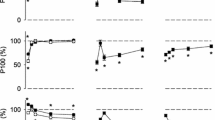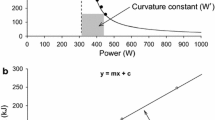Abstract
A new approach has been devised to assess the “static component” of dynamic exercise. This technique involves the measurement of the isometric endurance of muscles which have just taken part in rhythmic exercise and depends on the repeatability of trained subjects in isometric effort. The premise is that isometric endurance will be inversely related to the static component of the preceding dynamic exercise. The subjects worked on a bicycle ergometer at known fractions of their maximal aerobic capacity (max\(\dot V_{O_2 } \)). The rate of pedalling was varied from 30 to 90 rpm, so that for a given % max\(\dot V_{O_2 } \), the belt tension varied inversely with the speed of cycling. At any one speed of cycling, isometric endurance decreased as the belt tension increased. Following exercise at 30 rpm, the isometric endurance was 25 to 50% lower than that found at the most advantageous speed of cycling for our subjects; at these faster rates of cycling two subjects showed least static component following exercise at 90 rpm while the remaining subject performed best after cycling at 50 rpm.
Similar content being viewed by others
References
Atzler, E.: Probleme und Aufgaben der Arbeitsphysiologie. Ergebn. Physiol.27, 709–761 (1927)
Atzler, E., Herbst, R., Lehmann, G., Müller, E. A.: Arbeitsphysiologische Studien. Pflügers Arch. ges. Physiol.208, 184–239 (1925)
Benedict, F., Cathcart, E. P.: Muscular work, Publ. No. 187. Washington: Carnegie Institute 1913
Cathcart, E. P., Richardson, D. T., Campbell, W.: Studies in muscle activity. J. Physiol. (Lond.)58, 323–361 (1924)
Clarke, R. S. J., Hellon, R. F., Lind, A. R.: The duration of sustained contractions of the human forearm at different muscle temperatures. J. Physiol. (Lond.)143, 454–462 (1958)
Dickinson, S.: The efficiency of bicycle pedalling, as affected by speed and load. J. Physiol. (Lond.)66, 242–255 (1929)
Furusawa, K.: Muscular exercise, lactic acid, and the supply and utilization of oxygen. Proc. Roy. Soc. B99, 155–166 (1926)
Hermansen, L., Saltin, B.: Oxygen uptake during maximal treadmill and bicycle exercise. J. appl. Physiol.26, 31–37 (1969)
Hill, A. V.: The maximum work and mechanical efficiency of human muscles, and their most economical speed. J. Physiol. (Lond.)56, 19–41 (1922)
Lind, A. R.: Muscle fatigue and recovery from fatigue induced by sustained contraction. J. Physiol. (Lond.)147, 162–173 (1959)
Lind, A. R., McNicol, G. W., Donald, K. W.: Circulatory adjustments to sustained (static) muscular activity. Proc. Sympos. Physical. Activity in Health and Disease Vol 39. Oslo: Universitets-forlaget 1966
Lind, A. R., Rochelle, R., Petrofsky, J. S., Rinehart, J. S., Burse, R. L.: Isometric fatigue induced by different levels of rhythmic exercise. J. appl. Physiol. (1975, submitted for publication)
Lupton, H.: An analysis of the effects of speed on the mechanical efficiency of human muscular movements. J. Physiol. (Lond.)57, 337–353 (1923)
Margaria, R., Edwards, H. T., Dill, D. B.: The possible mechanisms of contracting and paying the oxygen debt and the role of lactic acid in muscular contraction. Amer. J. Physiol.106, 367–394 (1933)
Petrofsky, J. S., Lind, A. R.: The relationship of body fat content to deep muscle temperature and isometric endurance. Clin. Sci. (1974, in press)
Rohmert, W.: Untersuchung über Muskelermüdung und Arbeitsgestaltung. In: Arbeits-wissenschaft und Praxis. Berlin-Köln-Frankfurt: Beuth-Vertrieb 1967
Simonson, E., Sirkina, S.: Über den Einfluß von Belastung und Bewegungspausen auf die Stimulation von Kreislauf und Stoffwechsel. Arbeitsphysiologie6, 553 (1933)
Stier, F.: Die Geschwindigkeit von Armbewegungen. Int. Z. angew. Physiol.18, 82 (1959)
Wiley, R., Lind, A. R.: Respiratory responses to sustained static muscular contractions in humans. Clin. Sci.40, 221–234 (1971)
Author information
Authors and Affiliations
Rights and permissions
About this article
Cite this article
Petrofsky, J.S., Rochelle, R.R., Rinehart, J.S. et al. The assessment of the static component in rhythmic exercise. Europ. J. Appl. Physiol. 34, 55–63 (1975). https://doi.org/10.1007/BF00999916
Received:
Issue Date:
DOI: https://doi.org/10.1007/BF00999916




